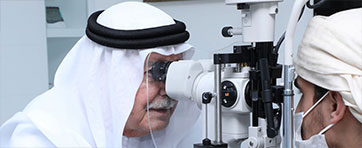Dry Eyes Syndrome
published on: 01st june, 2021
Dr. Yahya Ali Yahya Al Midwahi is the first Emirati Ophthalmologist, a ConsultantOphthalmologist, and the Co-founder and Chairman of Samaya Specialized Center's Board of Directors. He served as the Medical Director and Head of Eye Department from 1984 to 2008 of Mafraq Hospital's and is a member of its Appointment and Evaluation Committee. He is a member of the Arab Board of Health Specializations, American Academy of Ophthalmology and European Society of Cataract and Refractive Surgeries. He is a life member of the American Medical Society of Vienna and a member and UAE representative for the Arab Council of Scientific Specialties and under the Ministry of Health, he is a Chairman of the Ophthalmic Committee, member of its Medical Board and member of its Drugs Committee.
What is Dry Eye?
Dry Eye or Keratoconjunctivitis sicca is a multifactorial disease of the tears and ocular surface which is a common complaint among middle-aged and older adults, with increased prevalence in patients with autoimmune disease. It also affect post-menopausal women and the elderly. It commonly occurs after an episode of viral keratoconjunctivitis or severe acute or subacute conjunctivitis.
What Causes Dry Eye?
Increased tear evaporation (70% of UAE's population is known to be affected) Decreased tear production (30% of UAE's population is known to be affected)
Aggravating Causes and Factors for Dry Eye
- due to aging, medical conditions, medications and corneal nerve desensitivity
- due to posterior blepharitis
- due to less frequency of blinking
- due to eyelid problems and eye allergies
- due to topical eyedrops preservatives
- due to environment's condition (wind, smoke, air, climate, etc.; common in the UAE)
- due to Vitamin A deficiency (low in Vitamin A diet)
- due to entropion (turning in of the eyelids), ectropion (turning outward of the eyelids)
- due to computer screen time, reading, and other activities that reduces blinking
- due to the wearing of contact lenses and refractive surgery such as LASIK
Risk Factors
- Being older than 50 years of age due to the diminished tear production
- Being a woman due to hormonal changes
- Low in Vitamin A diet
- Contact lenses wearing
- History of refractive surgery
Signs and Symptoms
- Stinging, burning, scratchy, and something in the eyes types of sensation
- Stingy mucus around or inside the eyes
- Light sensitivity
- Eye redness
- Contact lens wearing difficulty
- Night time driving difficulty
- Watery eyes
- Blurred vision
- Eye fatigue
Management
- Lubrication drops and ointment
- Anti-inflammatory drops for severe cases Prescription of methamphetamine, multivitamins (Vitamin A, Omega-3 Fatty Acids, etc.), anti- inflammatory, mental blocks Punctal plugs
References:
Bik, D., Mati?, S., Bara?, J., Jeli? Vkovi?, M., Bik, E., & Mati?, M. (2013). Chalazion management–surgical treatment versus triamcinolone application. Collegium antropologicum, 37(1), 247-250.
Mustafa, T. A., & Oriafage, I. H. (2001). Three methods of treatment of chalazia in children. Saudi Med J, 22(11), 968-72.
Gupta, I., Sood, R., Sri, J., & Bhardwaj, S. (2021). Clinicopathological Evaluation Of Eyelid Lesions-A Clinical Study. European Journal of Molecular & Clinical Medicine, 7(8), 3655-3660.
recent posts
- Understanding Blepharitis: Causes, Symptoms, and Treatment Options
- The Role of Technology in Cataract Surgery: Abu Dhabi's Latest Techniques
- Understanding Keratoconus: Causes, Symptoms, and Diagnosis in Abu Dhabi
- Clearing the Fog: Understanding Glaucoma's Silent Threat to Vision
- Battling the Eye's Bumps: All You Need to Know About Pinguecula
- Understanding Pinguecula: Causes, Symptoms, and Management
- What Should I Consider When Choosing the Best Eye Hospital in Abu Dhabi?
- What is Diabetic Retinopathy?
- Diabetic Retinopathy
- What is Glaucoma?
- Eye Squint (Strabismus)
- Keratoconus
- Cataract
- Chalazion
2024. All Rights Reserved Samaya Specialized Center
